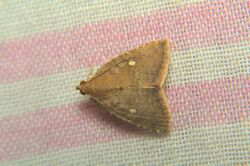Biology:Amyna axis
| Amyna axis | |
|---|---|

| |
| Amyna axis, Oriental Eight-Spot, India | |
| Scientific classification | |
| Domain: | Eukaryota |
| Kingdom: | Animalia |
| Phylum: | Arthropoda |
| Class: | Insecta |
| Order: | Lepidoptera |
| Superfamily: | Noctuoidea |
| Family: | Noctuidae |
| Genus: | Amyna |
| Species: | A. axis
|
| Binomial name | |
| Amyna axis (Guenée, 1852)
| |
| Synonyms | |
| |
Amyna axis, the oriental eight-spot, is a moth of the family Noctuidae. The species was first described by Achille Guenée in 1852.
Distribution
It occurs in Africa, temperate Asia, Australia and the Cook Islands. The New World population of Amyna axis was determined to be a separate species, Amyna stricta, in 2015.[1][2][3]
The moth migrates north each year in late summer and fall.
Food plants
The larvae feed on Amaranthus, Croton, Celosia, Digera, Helianthus, Chenopodium, Spinacia, Ipomoea, Ricinus, Arachis, Crotalaria, Medicago, Phaseolus, Hibiscus, Cardiospermum, Solanum, Corchorus and Parasponia species.[4][5]
It is an irregular minor pest of mung beans (Vigna radiata), black-eyed peas (Vigna unguiclata), lucerne (Medicago sativa) and soy beans (Glycine max). Its prevalence may be under reported due to the resemblance of the caterpillar with those of Chrysoieixis species.[1]
Early stages
The larvae are thin bodied and have faint white stripes and two pairs of ventral prolegs.[1] At low densities of groups, caterpillars are pale green. Among caterpillars at high densities, there are higher frequencies of melanistic phenotypes. The degree of blackening varied widely, ranging from individuals with simple subdorsal-lateral patches to those that were mostly black.[4]
Larvae perch on the undersides of leaves and along stems and petioles. At rest, the abdominal segments are often looped upward. When alarmed the larva essentially jumps from the host and continues to wreathe and wriggle wildly. Prepupal larvae take on a pinkish cast. Pupation occurs in a silken cocoon below (usually) or at the soil surface. Sand and/or plant debris are interwoven into the cocoon wall.[4]
Adult
The adult moth is chocolate brown above and has a wingspan of 20–25 mm (0.79–0.98 in). The forewings have faint greyish-white lines and an obscure figure-of-eight mark on it. The hindwings are lighter with fainter markings. The male can be differentiated by the presence of a small semi-transparent patch on each wing.[1] Adults are on wing in late summer and early fall. Forewing of male with a small vesicle in cell, with a small valve of scales over it on underside, the median nervure being slightly curved. It is smaller than Amyna punctum.[6]
References
- ↑ 1.0 1.1 1.2 1.3 Bailey, Peter (2007). Pests of Field Crops and Pastures: Identification and Control. CSIRO Publishing. pp. 247–248. ISBN 978-0-643-06758-5. https://books.google.com/books?id=N10sAEHunWEC. Retrieved 29 April 2010.
- ↑ Lafontaine, J. Donald; Schmidt, B. Christian (2015). "Additions and corrections to the checklist of the Noctuoidea (Insecta, Lepidoptera) of North America north of Mexico, III". ZooKeys (527): 227–236. doi:10.3897/zookeys.527.6151. PMID 26692790.
- ↑ "North American Moth Photographers Group, Amyna axis". http://mothphotographersgroup.msstate.edu/species.php?hodges=9070.
- ↑ 4.0 4.1 4.2 Wagner, D. L.; Binns, S. (2010). "Larva and pupa of Amyna axis (Guenée, 1852) and affirmation of its taxonomic placement in Bagisarinae (Lepidoptera, Noctuidae)". ZooKeys: 4. ISSN 1313-2970. http://pensoftonline.net/zookeys/index.php/journal/article/view/435/389. Retrieved 29 April 2010.
- ↑ "Amyna axis, Guenée, 1852". http://www.africanmoths.com/pages/EREBIDAE/BOLETOBIINAE/amyna%20axis.htm. Retrieved 3 August 2016.
- ↑ Hampson, G. F. (1894). The Fauna of British India, Including Ceylon and Burma: Moths Volume II. Taylor and Francis. https://www.biodiversitylibrary.org/item/180400#page/5/mode/1up.
External links
- McLeod, Robin (February 2, 2017). "Species Amyna stricta - Eight-Spot - Hodges#9070". https://bugguide.net/node/view/87294. Retrieved January 12, 2019.
Wikidata ☰ Q4749565 entry
 |

